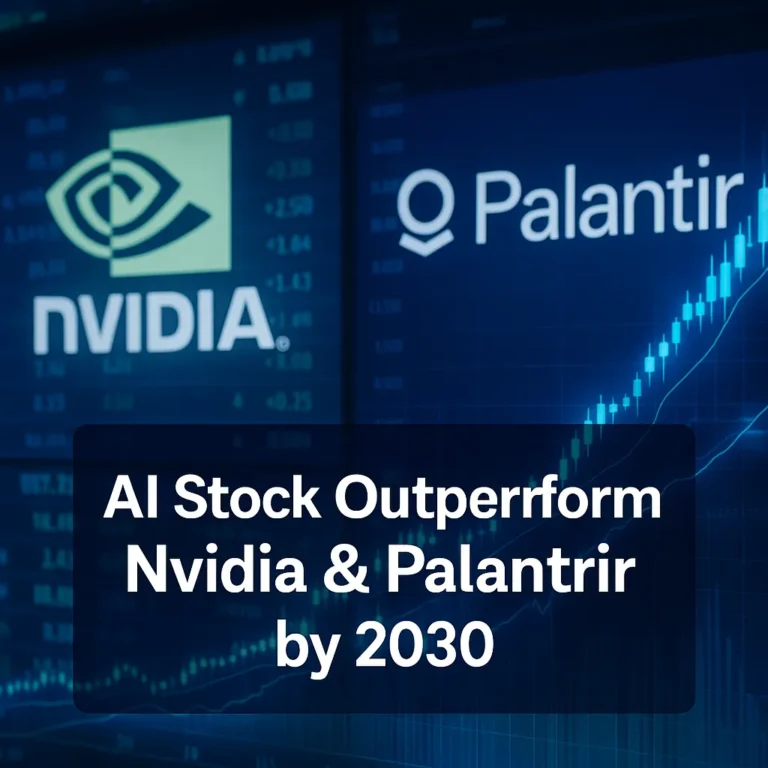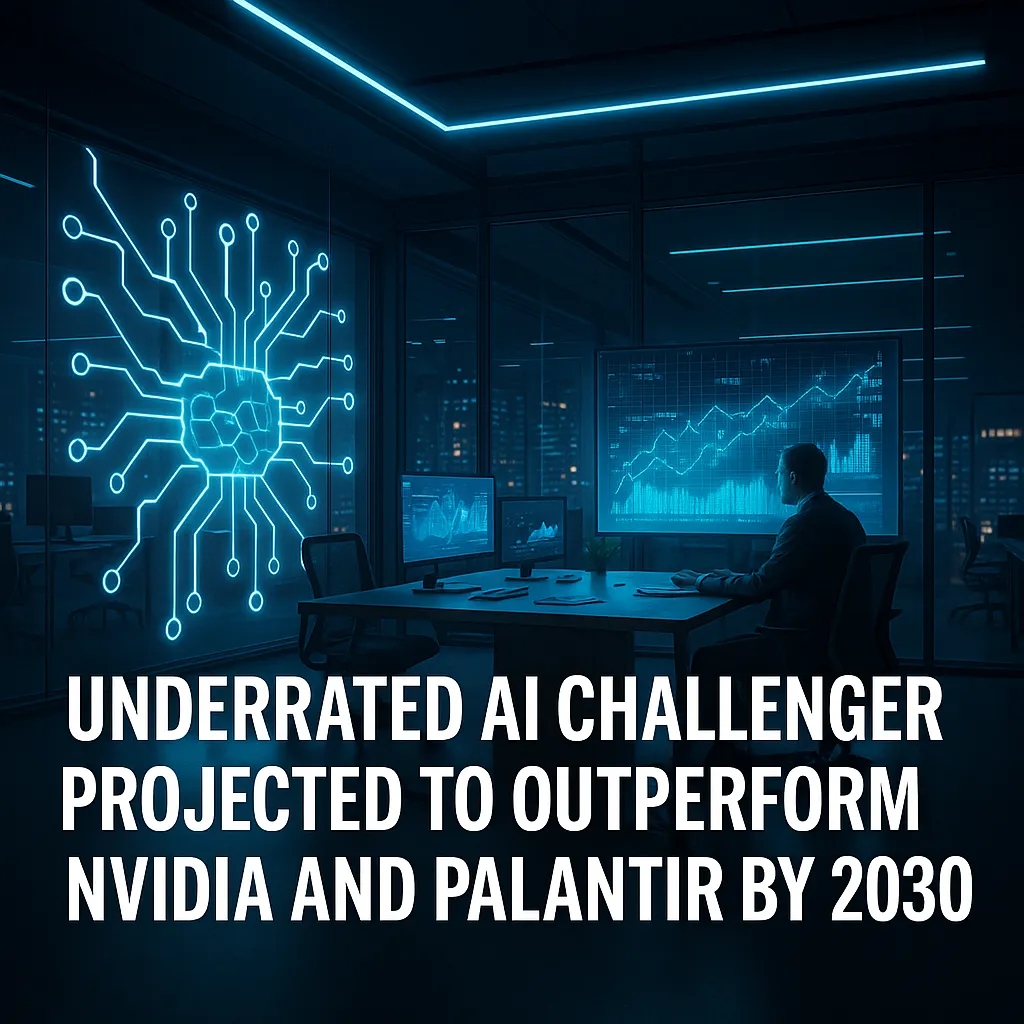
1 Artificial Intelligence Stock Predicted to Outperform Nvidia and Palantir by 2030
The race for dominance in artificial intelligence has been led by giants like Nvidia and Palantir, but analysts suggest that one overlooked AI stock outperform nvidia palantir 2030 could surprise the market in the next decade. With accelerating AI adoption across industries, identifying the best AI stocks 2030 requires careful analysis of both current leaders and emerging challengers.
This report examines Nvidia’s chip dominance, Palantir’s government contracts, and why an alternative stock could deliver superior returns by 2030. For investors focused on artificial intelligence stock forecast opportunities, the key is balancing hype with fundamentals while keeping an eye on disruption. Long-term growth in AI applications—from healthcare to finance to robotics—creates opportunities that extend well beyond the Nvidia vs Palantir AI competition.
Key Points
- 📌 Nvidia leads AI chips, while Palantir dominates data-driven AI platforms.
- 🎯 One overlooked stock is projected to outperform Nvidia and Palantir by 2030.
- 📊 Covers artificial intelligence stock forecast and best AI stocks 2030.
- 💡 Focus on long-term investing AI strategies amid global AI growth.
- ⚖️ Highlights risks, competition, and catalysts shaping Nvidia vs Palantir AI competition.
Nvidia vs Palantir: The Current AI Competition
The debate around the AI stock outperform nvidia palantir 2030 narrative always begins with Nvidia and Palantir because both companies symbolize the two sides of artificial intelligence: hardware dominance on one end and software-driven analytics on the other. Nvidia remains the backbone of the AI revolution, with its GPUs powering nearly every large language model, cloud inference system, and machine learning research lab in existence today. Palantir, by contrast, has become the face of AI for governments, defense contractors, and enterprises that require secure, scalable, and mission-critical data-driven decision-making. Together, they highlight why the Nvidia vs Palantir AI competition is so closely watched by analysts and investors worldwide.
Nvidia’s growth is fueled by a combination of chip sales, high-margin software licenses, and partnerships with all of the hyperscalers—Amazon, Microsoft, and Google. Its ability to retain pricing power despite growing competition reflects the scarcity of alternatives capable of matching its performance. Palantir, meanwhile, has turned its once niche reputation into broad commercial adoption. Its Artificial Intelligence Platform (AIP) is expanding into healthcare, finance, energy, and logistics, producing recurring revenues and deepening customer relationships that are difficult for competitors to disrupt. These contrasting strengths make both companies essential to the artificial intelligence stock forecast conversation, yet they also leave room for challengers to carve out opportunities in specialized niches or enterprise verticals.
For investors evaluating the best AI stocks 2030, the Nvidia-Palantir rivalry provides a useful framework for understanding where the industry may evolve next. Nvidia’s reliance on hardware margins could eventually face pricing pressure as new chipmakers enter the space, while Palantir’s dependence on government contracts may cap growth if procurement cycles slow. This is why long-term investors should consider diversification. A strong case can be made for positioning not only in today’s leaders but also in tomorrow’s disruptors—companies that may not dominate headlines today but could generate exponential growth through specialized applications, unique data pipelines, or innovative monetization models. In this context, the question is not whether Nvidia and Palantir remain leaders, but whether an overlooked player can quietly outgrow them by 2030.
More insights: Penny Stock Alerts · Reuters · Bloomberg · CNBC
The Overlooked AI Challenger Poised to Outperform by 2030
While Nvidia and Palantir dominate most conversations in the AI sector, analysts tracking the AI stock outperform nvidia palantir 2030 thesis point out that the market is far too large and dynamic for only two names to capture all the value. The overlooked contender may not yet command headlines, but it is steadily building a foundation around proprietary datasets, enterprise partnerships, and scalable platforms that can compete in ways the current leaders cannot. The ability to deliver specialized solutions that directly solve industry-specific challenges is one reason why some experts believe this stock could eventually outperform both Nvidia and Palantir.
In evaluating the artificial intelligence stock forecast across the next decade, investors should consider not only scale but also adaptability. Nvidia’s chips and Palantir’s data platforms dominate horizontal applications, but vertical integration—where AI tools are tailored for healthcare, finance, logistics, or cybersecurity—could become the ultimate growth driver. The challenger stock under discussion has already demonstrated early traction in vertical AI, winning contracts in industries where accuracy, compliance, and security are mission-critical. These niche strengths may prove decisive in expanding margins and justifying premium multiples by 2030.

From an investment strategy perspective, the case for this stock is rooted in three critical factors: recurring revenue growth, platform stickiness, and disciplined reinvestment. Its revenue mix is increasingly subscription-based, which adds visibility to cash flows. Its product ecosystem encourages multi-product adoption, raising net retention rates. And its management team has shown an ability to reinvest profits into research without diluting shareholders. These attributes directly align with how analysts identify the best AI stocks 2030 and reinforce why the company is on watchlists for long-term investing AI strategies.
For context, this stock is not without risk. Like any emerging player, it faces competition from larger incumbents, execution challenges, and potential volatility in capital markets. However, if growth catalysts such as new product launches, global expansion, or major enterprise partnerships materialize, the upside potential could significantly outweigh near-term risks. This is why more institutional investors are beginning to explore the possibility that this company could become the silent outperformer in the Nvidia vs Palantir AI competition.
Analyst coverage: Motley Fool · Yahoo Finance · Investopedia
Artificial Intelligence Stock Forecast 2030
When investors explore the AI stock outperform nvidia palantir 2030 outlook, the conversation quickly turns to the pace of adoption and the durability of competitive moats. According to industry research, the global AI market is projected to expand at a compound annual growth rate of over 20% through 2030, which implies trillions of dollars in cumulative opportunity across hardware, software, and enterprise applications. This level of growth creates room for both incumbents and challengers to succeed, particularly if they can demonstrate platform scalability and recurring revenue streams.
Palantir remains a central name in the Nvidia vs Palantir AI competition thanks to its entrenched position in government and defense contracts. However, recent trends show accelerating adoption in commercial sectors such as healthcare, energy, and financial services, where its Artificial Intelligence Platform (AIP) is beginning to capture meaningful share. These contracts often extend multiple years, providing visibility for investors focused on long-term investing AI strategies. Yet, despite this strength, analysts argue that reliance on government clients leaves Palantir more exposed to budget cycles and regulatory constraints than diversified peers.
The broader artificial intelligence stock forecast suggests that the market will favor companies with sticky ecosystems and differentiated IP, which is why the search for the best AI stocks 2030 extends beyond Nvidia and Palantir. New entrants may find success by targeting vertical applications such as precision medicine, industrial automation, or cybersecurity—fields where specialized AI models can deliver outsize returns. These companies may lack Nvidia’s scale or Palantir’s government backing, but their agility and focus could allow them to grow faster in underpenetrated niches.
For investors, the lesson is clear: the AI stock outperform nvidia palantir 2030 candidate will likely be a company that balances rapid innovation with strong unit economics. Tracking ARR growth, gross margin expansion, and customer retention provides the clearest signals for who might lead by the end of the decade. Those who adopt a disciplined, data-driven approach to long-term investing AI will be best positioned to benefit when the next leader emerges.
Investment Risks & Strategy for a 2030 AI Outperformer
Even if one AI stock outperform nvidia palantir 2030 emerges, investors must price execution risk, competitive response, and policy shifts. A balanced approach blends conviction with discipline, applying a repeatable framework to evaluate artificial intelligence stock forecast scenarios across cycles.
Core risks include model commoditization (falling switching costs), hardware supply tightness, data-licensing disputes, and regulatory scrutiny in sensitive verticals. Offsetting these are durable moats—proprietary datasets, distribution, and mission-critical workflows—that often define the best AI stocks 2030 and reward long-term investing AI strategies.

Practical Playbook
- Moat first: Prioritize sticky platforms (high net retention, multi-product adoption) over hype.
- Unit economics: Track gross margin lift from inference efficiency and platform reuse.
- Pipeline signals: Watch signed backlog, ARR mix, and deployment velocity in enterprise deals.
- Risk controls: Use staged entries, position sizing, and predefined exits; avoid thesis creep.
- Diversify exposure: Balance the Challenger with leaders in the Nvidia vs Palantir AI competition to reduce idiosyncratic risk.
Act on signals with: Penny Stock Alerts · Day Trade Alerts · Swing Trade Alerts
FAQs
1) Which AI stock could outperform Nvidia and Palantir by 2030?
Analysts suggest an underfollowed AI stock outperform nvidia palantir 2030 could emerge from verticalized AI or enterprise platforms with durable moats and recurring revenue growth.
2) What is the artificial intelligence stock forecast for 2030?
Most artificial intelligence stock forecast models expect 20%+ CAGR for the sector, with leaders and challengers sharing growth depending on adoption, regulation, and margins.
3) What are the best AI stocks 2030 investors should watch?
Beyond Nvidia and Palantir, the best AI stocks 2030 could include enterprise SaaS providers, chip startups, or niche AI platforms with proven scalability.
4) How should long-term investors approach AI?
Long-term investing AI requires focusing on ARR, platform stickiness, moat durability, and pipeline visibility, while managing hype cycles and volatility.
5) How does the Nvidia vs Palantir AI competition shape the sector?
The Nvidia vs Palantir AI competition defines today’s landscape: Nvidia leads in hardware and chips, Palantir in data platforms—but challengers could change the balance by 2030.
Conclusion
The AI stock outperform nvidia palantir 2030 narrative reflects the sector’s dynamism: while Nvidia and Palantir are today’s benchmarks, overlooked players could outgrow them in the next decade. Investors who evaluate artificial intelligence stock forecast scenarios with discipline, identify the best AI stocks 2030, and pursue long-term investing AI strategies can capture multi-year compounding opportunities. Tracking catalysts, market share shifts, and disruptive innovation will be essential in positioning for AI’s next era.

Pauline Lei
Pauline Lei is a financial markets contributor at TradeStockAlerts.com. She covers AI, tech, and growth equities, providing actionable insights for investors with a focus on long-term positioning.